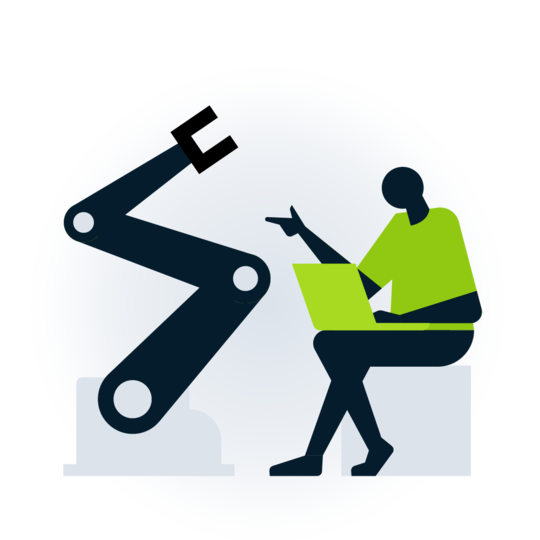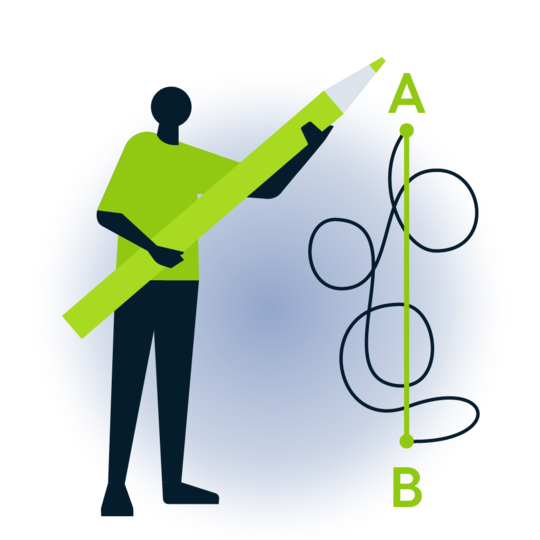Make administration and finance employees more productive
Nimble helps administration and finance employees to work more effectively, so that they have a better overview and work less error-prone.
-
Process incoming and outgoing documents with RPA
Process incoming and outgoing documents with RPA
RPA (or Robotic Process Automation) is a technology that uses robots to automate repetitive actions. With the help of RPA, you can work more efficiently, minimize the chance of errors and focus on more valuable and challenging assignments.
Disadvantages of manual processing
The more documents that come in and out, the higher the workload. The higher the workload, the higher the chance of making mistakes. Typing mistakes, misinterpreting data or forgetting certain actions is human, but it can lead to serious consequences. Think of delays, dissatisfied customers or in some cases financial damage.
Unfortunately, the manual processing of these documents is also not scalable. As the number of incoming and outgoing documents increases, it is difficult to keep up with the workload and it may be necessary to deploy additional staff for this.
Why RPA?
RPA can speed up and simplify this entire process for you. For incoming and outgoing documents, robots can scan and recognize documents for you, extract and send information and enter data into the right databases. All actions are taken care of for you.
Because robots follow fixed patterns and do not deviate from this process, the chance of human error is minimized. Because the tasks are always carried out in the same way, there is also more clarity in the process. All actions are carried out in a similar manner, so there is no possibility of mutual ambiguity or misinterpretation.
Deploying RPA can also lead to significant cost savings. By using robots, fewer resources and staff are needed to carry out this process. This also allows staff to spend more time on other tasks with more added value.
RPA in practice
For incoming documents, RPA allows documents to be automatically classified and sorted based on various criteria, such as: sender, type of document or date. This feature can greatly reduce the time and effort required to manually sort and organize the documents.
Robots can also recognize data from documents, sort it out and then place it in a database. Consider, for example, an invoice, here it is important to clearly store the customer number, Chamber of Commerce number and the year. A robot can track down this data from a document for you, copy it and then put it in the right file. In addition to recognizing and entering the correct data, robots can also check for incorrect or missing information.
For outgoing documents, RPA can help you using document generation. Instead of investing time and effort in manually creating and drawing up invoices or quotations, for example, you can have this automated. The data needed for this can be plucked from files and then merged into an automatically generated document.
After a document has been automatically generated and passed the validation check, it can be sent. The robot can arrange this itself by, for example, extracting the correct e-mail address of a recipient from the CRM system and then pasting it into the address bar of an e-mail draft.
The process that the robot goes through for these tasks can also be easily monitored. Think of providing insight into processing times, number of documents processed, types of documents and the number of errors and/or exceptions. These insights can be used to further optimize the document processing process.
-
Drafting contracts using low-code, RPA and BPMN
Drafting contracts using low-code, RPA and BPMN
Drafting a contract is a time-consuming and often complex task. There are numerous factors within a contract that need to be taken into account. For example, you can think of substantive matters that need to be tailored to the company and the employee, but also legal matters.
Clarity and accuracy
It is therefore important that a contract is clear and accurate, in order to avoid any disputes in the future. With technologies such as low-code and Robotic Process Automation (RPA) and Business Process Model Notation (BPMN), this can be achieved without compromising on quality or speed.
Low-code application for drawing up a contract
Low-code is a development method that allows applications to be written with as little handwritten code as possible. Instead of complex programming languages, visual elements are used so that an application can be developed quickly and easily. This can be very useful for drafting a contract to adapt it to specific wishes and requirements of both parties.
A low-code platform provides standard templates for common contracts, such as an employment contract, lease agreement, and sales agreement. These templates can be customized to specific things for each contract by changing certain fields and adjusting conditions. This allows a contract to be drawn up much faster than it would have been drawn up manually.
Read more about the low-code solutions of Nimble.
Using Robotic Process Automation (RPA) for compiling contracts
Robotic Process Automation (RPA) is a technology that is increasingly being applied in various industries, such as administration and finance, to increase efficiency and productivity. One of the areas of application of RPA is the drafting of contracts.
Contracts are often complex legal documents that bind two parties to certain conditions and obligations. Drafting contracts is often a time-consuming and complex process, which requires a lot of human effort, which means that error sensitivity is increasingly present. The process begins with gathering the right information, formulating the terms and drafting the final version of the contract. The contract must then be reviewed and approved by all parties involved before it can be signed.
RPA can be used to automate and speed up this process. An RPA system can be programmed to perform specific tasks, such as gathering the necessary information and drafting the draft version of the contract. The system can also be configured to review and approve the different versions of the contract, and to sign the final version of the contract.
Read more about RPA by Nimble.
Using BPMN for compiling contracts
Business Process Model and Notation (BPMN) is a modeling language used to visualize and document business processes. BPMN is often used by companies to analyze, improve and automate processes. However, it can also be used for other purposes, such as drafting legal contracts. Nimble specializes in deploying low-code and BPMN solutions for employees in the administration and finance department.
-
Handling sick reports using low-code
Handling sick reports using low-code
Handling sick calls is an important part of the administration and finance departments of companies. It is essential to be able to respond quickly and accurately to employee sick calls, to ensure that the right steps are taken and that payroll is kept up to date. Nimble helps companies streamline sick calls within administrative processes.
Automatically pass on sick reports to the right department with low-code
When handling sick reports, low-code solutions from Nimble can be used, for example, to automate the process of passing on the sick report. When an employee calls in sick, this information can be automatically forwarded to the right people within the organization, for example to the HR department and the finance department.
Process payroll administration with a Nimble application
The Nimble application can then automatically perform the necessary actions, such as updating the payroll administration and sending messages to the relevant persons.
In addition to improving efficiency and streamlining processes, the use of low-code solutions can also contribute to the safety and security of sensitive information.
Calling in sick automatically goes to the right person
Have actions performed automatically
Security of sensitive information -
Using RPA for payroll processing
Using RPA for payroll processing
RPA is an innovative solution that has become increasingly popular in recent years in administration and finance departments within companies. RPA can speed up and automate processes. Payroll processing is a repetitive task and therefore perfect to apply RPA to.
The traditional way of payroll processing is a manual execution. This takes a lot of time and energy. In addition, it entails error sensitivity. RPA solutions allow the process to be automated, making it more accurate, faster and more cost-efficient. It is important to note that RPA is not intended to replace human labor, but to support employees and make their work easier.
One of the main benefits of using RPA for payroll processing is that it improves the accuracy of the data.
RPA bots can automatically collect and process data from a variety of sources, resulting in faster and more efficient payroll processing.
Moreover, the use of Robotic Process Automation also offers significant cost savings. By automating routine tasks and processes, the need for additional staff is reduced. This allows companies to better manage their budgets and save money on labor costs.
Accurate
Fast processing
Cost savings








